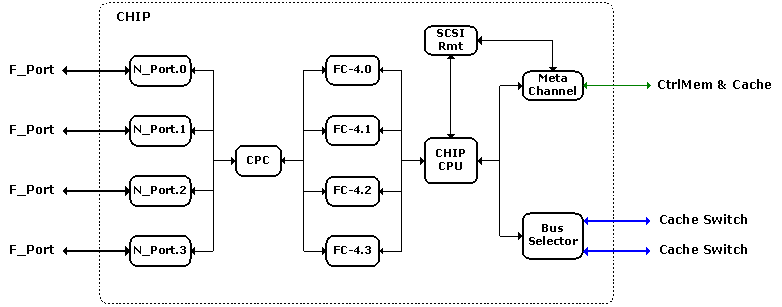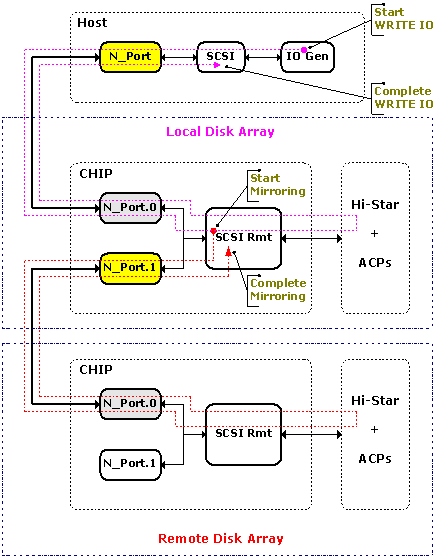![]() Return to Home -->
Modules -->
Device - Disk Array
Return to Home -->
Modules -->
Device - Disk Array
CHIP Module
Both Host and CHIP are Node modules and they work alike. Same as Host, CHIP has one or more N_Ports and their associated Port Drivers, a CHIP Peripheral Bus Controller (CPC - same as HPC), a CHIP CPU (no much difference from a Host CPU), and a SCSI Layer. Different from Host, CHIP uses a Meta Channel to exchange control information with Control Memory and Cache (CtrlMemCch), and a Bus Selector to exchange data information with CtrlMemCch through Cache Switches. Note multiple Cache Switches may exist so that the Bus Selector can choose the least congested path to transfer data. Another difference from Host is that CHIP implements a SCSI Layer subset (SCSI Rmt) that is dedicated to the Remote Mirroring or Data Replica operations. Note the Remote Mirroring or Data Replica is not the very beginning source of the IO operations so CHIP won't setup IO Generator as Host does. Following figure shows an example CHIP module with four N_Ports installed and two Cache Switches connected.
![]() Mouse over the boxes to view specific modules.
Mouse over the boxes to view specific modules.

CHIP Module
Click here to see its VML version (requiring IE)
SCSI Layer for Remote Mirroring (SCSI_Rmt)
SCSI_Rmt is dedicated to the Remote Mirroring operation. In SimSANs the Remote Mirroring is asynchronous - local disk array can issue SEND_CMD_COMP (refer to SCSI_FCP) to complete a SCSI WRITE IO without waiting for the completion of the correspondent mirrored WRITE IO. The following figure shows the basic work flow about asynchronous remote mirroring implemented in the SimSANs. The yellow color boxes are Initiator N_Ports and the light gray color boxes are Target N_Ports. Pink color dotted line denotes the I/O path for normal SCSI WRITE IOs and the red color dotted line denotes the I/O path for mirrored SCSI WRITE IOs. In SimSANs, the mirroring operation requires a target LUN being setup in two separate Disk Arrays and assigned the same LUN WWN (refer to System Configuration for more about LUN setting). Currently we cannot perform mirroring across more than two Disk Arrays. Note both local Disk Array and remote Disk Array do not necessarily reside in separate Data Centres although the asynchronous mirroring is always operated across Data Centres remotely inter-connected (usually several hundred to several thousand kilometers). SCSI_Rmt also performs the following tasks (refer to Host SCSI_Layer) same as what Host SCSI does: Initiator-Target Path creation and removal, LUN Masking, and IO Error Detection and Recovery, etc. Note each mirrored WRITE IO must be single-DATA_Action IO so its SCSI_IOSB contains only one SubIOSB, i.e., the IO is fulfilled by one SubIO.

Asynchronous Remote Mirroring
Click here to see its VML version (requiring IE)
This page was last updated 2003.10.15